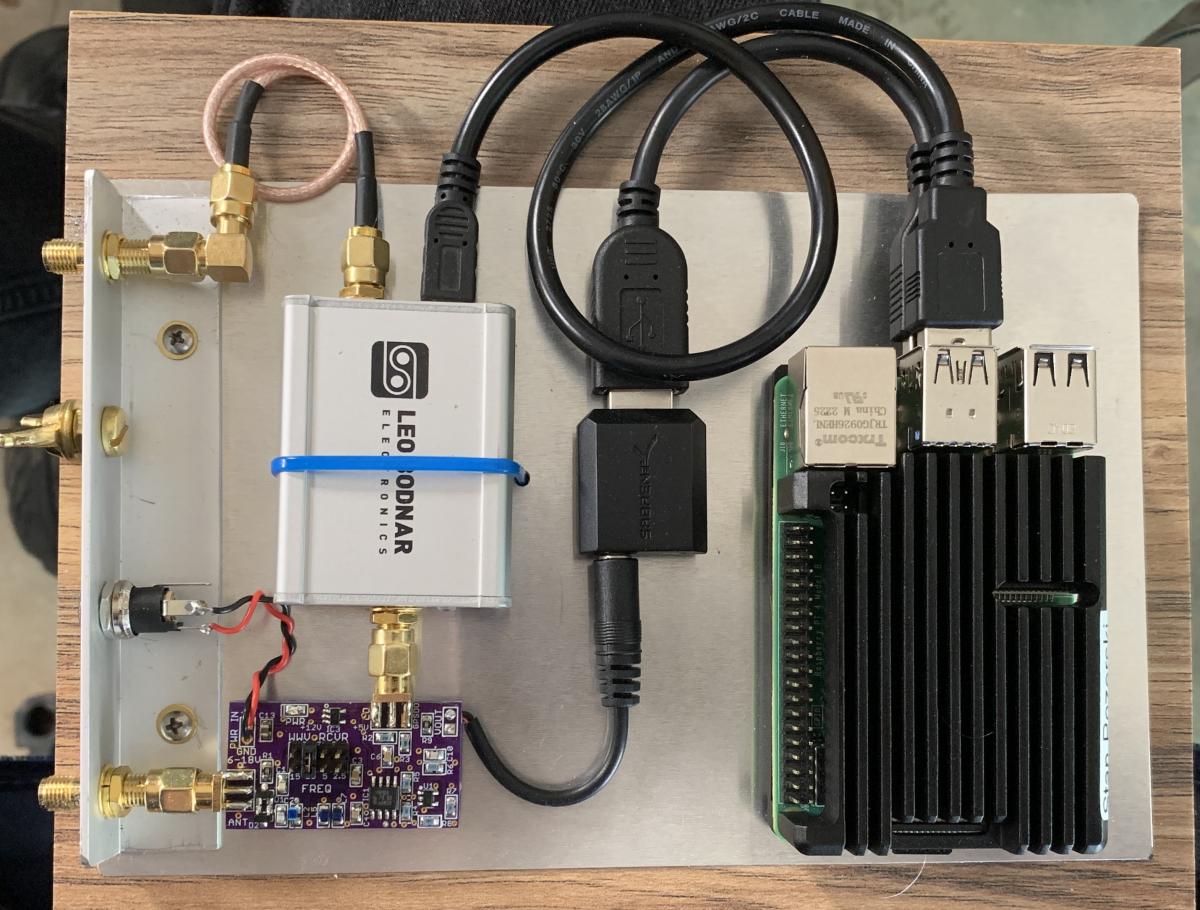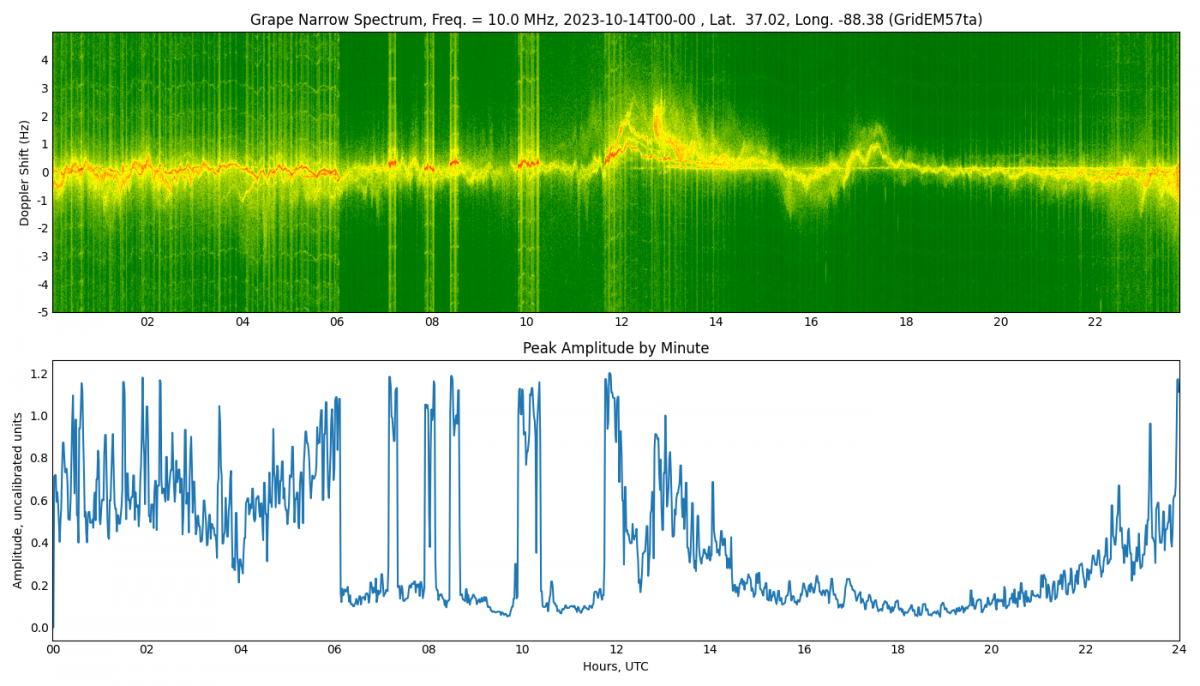GRAPE 1 DRF - Overview, Specifications, Sourcing
 |
 |
Overview
The GRAPE 1 Doppler Monitor is a key component of the HamSCI Personal Space Weather Station (PSWS). It functions well as a stand alone module. GRAPE 1 DRFs have been providing scientifically useful Doppler shift data since September, 2023. The GRAPE 1 was designed with a specific purpose in mind: Receiving, analyzing and recording of signals from frequency standard stations such as WWV/H and CHU.The PSWS project involves monitoring changes in the Earth's ionosphere through measurements of Doppler frequency shifts on a 24/7 basis. One well built example of a GRAPE 1 DRF Doppler Monitor appears above, along with a plot of Doppler shift and signal amplitude vs. UTC hour from April 8, 2024 (the date of the recent North American total solar eclipse)appears above. (The solar eclipse's effect on the ionosphere is clearly visible in the green Doppler shift plot, between about 1600 and 1800 UTC.)
This particular vision of the GRAPE(GRAPE = Great Radio Amateur Propagation Experiment) is relatively easy to assemble, and then it takes some care to prepare the software. Hosting involves building a GRAPE low-IF receiver board, obtaining a GPS Disciplined oscillator, Raspberry Pi, disk drive, providing reliable power, space for an antenna and an Internet connection. Other factors come into play, such as the need for visibility to the constellation of GPS satellites. Complete documentation (schematics, bill of materials) and instructions for building the GRAPE 1 low-IF receiver board, as well as configuring the GRAPE 1 DRF-specific Raspberry Pi image, are available on this website. Note: The GRAPE is a receive-only device. An amateur (ham) radio license is not required to operate a GRAPE 1 Doppler Monitor!
Specifications
| Purpose | Single frequency, low-IF receiver, used for measuring Doppler shift while receiving frequency standard stations such as WWV/H or CHU. Data is useful for studying bottom side motion of the ionosphere. |
| Frequency Selections | 2.5, 5.0, 10.0 or 15.0 MHz (reduced though very acceptable performance on 3.33, 7.58 or 14.36 MHz) |
| Frequency Stability | As stable as the Leo Bodnar GPS disciplined oscillator, approaching 1x10-12 |
| Sensitivity | Under review |
| Dynamic Range | Under review |
| Received Bandwidth | Under review |
| Current Hardware Version | See Builders Information in the Sourcing section, below |
| Required Computer | Raspberry Pi 4B, 8 GB memory |
| Operating System | Ubuntu |
| Required software | GNU Radio, plus various GRAPE 1 DRF-specific Python routines (all are included with the GRAPE-1 DRF image - see Builders Information, in Sourcing section, below) |
| Data Repository | The GRAPE 1 DRF data is freely accessible, available for viewing, plotting and downloading from the Personal Space Weather Station Central Control System (self-created user account required). |
Sourcing
Note: A number of GRAPE 1 DRF systems were funded by a grant from the National Science Foundation, and then assembled and deployed by volunteers (The New England GRAPE Group) in mid-2023. Occasionally, units are returned to HamSCI for redeployment. If you are interested in hosting a grand-funded GRAPE 1 DRF, please send your contact info, including location (grid square and city/state/province) to hamsci@hamsci.org. Note that grantees are expected to have basic Linux experience, an HF (shortwave) antenna, common computing peripherals (USB keyboard/mouse, monitor) and an Internet connection (wired Ethernet preferred) for daily data uploads. Of course, we can't guarantee availability but we are very interested in having as many systems running as possible.
Builders's Information: The GRAPE 1 is suitable for the DIY enthusiast.
- The single-frequency receiver portion is built by the user on a PC board using surface mount components. Engineering and construction information for the GRAPE low-IF receiver board is available here
- Additional purchased components (GPS disciplined oscillator, Raspberry Pi, USB sound card, disk drive, power supply) are programmed and/or interconnected to form a GRAPE 1 DRF system. A component list is available here.
- Commercially built or DIY antenna suitable for your location, distance from time standard station, appropriate for frequency being monitored
- Documentation for the GRAPE1-DRF is available here.
This video (courtesy of the American Radio Relay League) provides an excellent overview of the GRAPE 1.12 low-IF receiver
Further Information
- Support is available from the HamSCI-GRAPE Google Group. All are welcome to join, ask questions, assist others on their GRAPE journeys.
- HamSCI explains The Science Behind the GRAPE Doppler Monitor
- In mid-October, 2023, while an annular solar eclipse which transited North and South America, dozens of GRAPE 1 DRF systems were in operation, uploading research-worthy data. The GRAPE project contributors from that time period are noted on the GRAPE 1 Recognition and Acknowledgement page.
- The GRAPE 1 DRF is just one module of the HamSCI Personal Space Weather Station (PSWS) Learn more here: Overview of the Personal Space Weather Station (PSWS)
Credits
The GRAPE Version 1 was designed by John Gibbons, N8OBJ, Lab Director of the Sears Undergraduate Electrical Design Lab, Case Western Reserve University, Department of Electrical Engineering. Additional software applications were written by Bill Engelke, AB4EJ, of the University of Alabama. Bill was also the architect of the PSWS Central Control System. Dr. Nathaniel Frissell, W2NAF, was the Principal Investigator on National Science Foundation grant 2002278 ('Collaborative Research DASI Track 1 - Personal Space Weather Station'). Their efforts were supported by additional NSF grants (1922972, 1932997) and these institutions:

